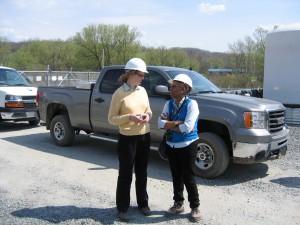October 16, 2010
 As I describe in the chapter, ‘What’s politics got to do with to do with it?’–more than we care to admit. Access to care is what we usually talk about.., but access to knowledge based on what research gets funded and access to treatment based on what drugs and products are approved relate to politics as well. And even access to information, as policy forms around labeling and package inserts and other ways to help us make informed decisions. All relate to politics… I was thinking about some of these issues while touring a Marcellus shale mining site and wondering about the health and welfare of workers and communities alike.
As I describe in the chapter, ‘What’s politics got to do with to do with it?’–more than we care to admit. Access to care is what we usually talk about.., but access to knowledge based on what research gets funded and access to treatment based on what drugs and products are approved relate to politics as well. And even access to information, as policy forms around labeling and package inserts and other ways to help us make informed decisions. All relate to politics… I was thinking about some of these issues while touring a Marcellus shale mining site and wondering about the health and welfare of workers and communities alike.
A couple of days ago, I posted my thoughts about events leading to how we talk about the focus on politics and access to health care In the U.S. Here are a few other events worthy of note… The Great Depression led the government to identify access to health care as a political priority. Now it was unemployed workers who were unable to pay for their own health care that got the government involved. Because so many workers were unemployed, this led doctors’ incomes to fall. Middle class citizens began to rely on public hospitals and state and local health departments to receive health care. In turn, doctors began providing more services through these venues. Doctors charged the welfare departments, and State welfare departments in turn charged the federal government. This cost-shifting system was supported by political priorities established in debates at the federal level and then by passage of such policy as the Social Security Act in 1935. 
President Truman expanded Social Security and recommended national health insurance in 1949. He continued to work toward it–unsuccessfully–until 1953. A role for government support of health care shifted from keeping workers working based on commerce to a role for government based on those in need or underserved–with the initial stimulus being the unemployed.
A role for government and politics in access to health care shows great expansion in the realm of the underserved and needy during the era of the Great Society, when Presidents Kennedy and Johnson expanded the social welfare and services system. The government’s role now extended well beyond keeping a work force healthy. The effort to provide health care included powerless groups, such as children and the elderly.
The government’s role in protecting workers’ health also grew during this era. But the focus shifted with new initiatives such as the Occupational Safety and Health Administration (OSHA), which was inaugurated in 1971, aligning with efforts to assure health and reduce the need for health care. In OSHA’s first three decades, fatalities in the workplace were cut in half, while injuries were cut 40%.
 A role for government in health care as a strategy to promote the economy began to threaten the economy as health care costs mounted in efforts to bridge the gaps associated with underserved groups. President Nixon reflected this reality in his attempt to decentralize decision-making about health care, reducing the federal government’s obligations in this realm. This was part of his policy of New Federalism, a doctrine designed to draw lines between issues for national versus state or local governments. Largely, this era focused on wresting control from the federal government and revenue-sharing with states, returning a portion of taxes collected back to state and local decision-making, policy from 1972 to 1986. President Reagan also used the term New Federalism in his block grant approach, shifting monies to state and local initiatives related to providing health care.
A role for government in health care as a strategy to promote the economy began to threaten the economy as health care costs mounted in efforts to bridge the gaps associated with underserved groups. President Nixon reflected this reality in his attempt to decentralize decision-making about health care, reducing the federal government’s obligations in this realm. This was part of his policy of New Federalism, a doctrine designed to draw lines between issues for national versus state or local governments. Largely, this era focused on wresting control from the federal government and revenue-sharing with states, returning a portion of taxes collected back to state and local decision-making, policy from 1972 to 1986. President Reagan also used the term New Federalism in his block grant approach, shifting monies to state and local initiatives related to providing health care.
President Clinton came into office with health care reform established as a priority. The six principles stated in a health care reform speech in 1993 reveal that the nation was not yet ready to accept limits associated with access: [1] Security: Guaranteed, comprehensive benefits; [2] Savings: Controlling health care costs; [3] Quality: Making the world’s best care better; [4] Choice: Preserving and increasing what you have today; [5] Simplicity: Reducing paperwork and cutting red tape; and [6] Responsibility: Making everyone responsible for health care. The first, third, and fourth principles reveal an emphasis on access, while the second, fifth, and sixth were the guides to be used in controlling cost. The conflict in pursuit of these two divergent paths contributed to the plan never passing, which leaves the government’s obligation in access to health care in a costly dilemma…and that is how we talk about health care in the U.S.–as a costly dilemma relating to assuring the health of workers who will contribute to the economic well-being of the country and assuring the health of groups unable to access care on their own…
 October 24, 2010
October 24, 2010
 As I describe in the chapter, ‘What’s politics got to do with to do with it?’–more than we care to admit. Access to care is what we usually talk about.., but access to knowledge based on what research gets funded and access to treatment based on what drugs and products are approved relate to politics as well. And even access to information, as policy forms around labeling and package inserts and other ways to help us make informed decisions. All relate to politics… I was thinking about some of these issues while touring a Marcellus shale mining site and wondering about the health and welfare of workers and communities alike.
As I describe in the chapter, ‘What’s politics got to do with to do with it?’–more than we care to admit. Access to care is what we usually talk about.., but access to knowledge based on what research gets funded and access to treatment based on what drugs and products are approved relate to politics as well. And even access to information, as policy forms around labeling and package inserts and other ways to help us make informed decisions. All relate to politics… I was thinking about some of these issues while touring a Marcellus shale mining site and wondering about the health and welfare of workers and communities alike. 
 A role for government in health care as a strategy to promote the economy began to threaten the economy as health care costs mounted in efforts to bridge the gaps associated with underserved groups. President Nixon reflected this reality in his attempt to decentralize decision-making about health care, reducing the federal government’s obligations in this realm. This was part of his policy of New Federalism, a doctrine designed to draw lines between issues for national versus state or local governments. Largely, this era focused on wresting control from the federal government and revenue-sharing with states, returning a portion of taxes collected back to state and local decision-making, policy from 1972 to 1986.
A role for government in health care as a strategy to promote the economy began to threaten the economy as health care costs mounted in efforts to bridge the gaps associated with underserved groups. President Nixon reflected this reality in his attempt to decentralize decision-making about health care, reducing the federal government’s obligations in this realm. This was part of his policy of New Federalism, a doctrine designed to draw lines between issues for national versus state or local governments. Largely, this era focused on wresting control from the federal government and revenue-sharing with states, returning a portion of taxes collected back to state and local decision-making, policy from 1972 to 1986.  It was little more than a decade after the Constitution was adopted when the U.S. Congress debated a role for the government in providing health care for some
It was little more than a decade after the Constitution was adopted when the U.S. Congress debated a role for the government in providing health care for some 

 I know that we often build an understanding about health conditions based on asking people questions. As a form of communication, asking people health questions is both an art and a science. How do we ask a question in a way that someone can give us an accurate and complete answer? If asked about how much diet soda you drink on an average each day, how do you decide to respond if you only drink diet soda when it is hot? Do you say, “none,” because it is winter? Do you respond “less than one a day” because you divide it out and even though you may drink a six-pack a day in the summer, summer is only really two months long…so it seems to average out to…less than one a day?
I know that we often build an understanding about health conditions based on asking people questions. As a form of communication, asking people health questions is both an art and a science. How do we ask a question in a way that someone can give us an accurate and complete answer? If asked about how much diet soda you drink on an average each day, how do you decide to respond if you only drink diet soda when it is hot? Do you say, “none,” because it is winter? Do you respond “less than one a day” because you divide it out and even though you may drink a six-pack a day in the summer, summer is only really two months long…so it seems to average out to…less than one a day? suggests that her doctor used the evidence of a patient before him to guide a recommendation that the published medical research says was based on inconclusive data… And I say, “Let’s be truthful about what we mean when we talk about the data and the evidence. Let’s be willing to consider the ethical boundaries of research studies. Let’s realize that ‘inconclusive data’ sometimes means that a clinical trial, the gold standard of medical research, is not appropriate and so, there will never be “conclusive data”…
suggests that her doctor used the evidence of a patient before him to guide a recommendation that the published medical research says was based on inconclusive data… And I say, “Let’s be truthful about what we mean when we talk about the data and the evidence. Let’s be willing to consider the ethical boundaries of research studies. Let’s realize that ‘inconclusive data’ sometimes means that a clinical trial, the gold standard of medical research, is not appropriate and so, there will never be “conclusive data”… September 21, 2010
September 21, 2010 August 28,2010
August 28,2010 It was a celebration of life. He thanked fans for their prayers and support for him during the past year. He literally seemed to breathe in the positive energy and well wishes of the fans at the concert. Which communicated something about health….
It was a celebration of life. He thanked fans for their prayers and support for him during the past year. He literally seemed to breathe in the positive energy and well wishes of the fans at the concert. Which communicated something about health….  July 14, 2010
July 14, 2010 June 20, 2010
June 20, 2010 June 11, 2010
June 11, 2010